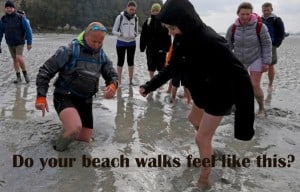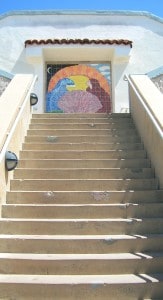- Are You A Hiker or a Beach Walker? Do You Sometimes Have Hip Pain?
- Before Hiking Or Long Walks On The Beach, There Was Running
- I Was Experiencing Inverse Running
- Running Is Out
- You Compete Me: Climb Every Mountain
- “Youth is a wonderful thing. What a crime to waste it on children.”
- Beach Walking Is In
- True Indicators
- Self-Assessment & Denial?
- It Must Be The Equipment?
- Getting Older?
- Hip Pain And Flexibility Loss
- Groin Pull And Muscular Pain
- Diagnosis Uncertain
- Social Degradation
- Ineffective Nonsurgical Treatments
- Time Doesn’t Heal
- Loss Of Functional Mobility And Gait Abnormalities
- I Speak Slower
- Flamingo Pose
- All ‘Dem Bones Are Connected
- Some Things Heal, Some Don’t
Before Hiking Or Long Walks On The Beach, There Was Running: I have been active all my life. Worked-out, ran, played recreational team sports from high school, through college and into tavern leagues. As you get older it is harder to get the ‘team’ together, but I kept running…
Running on the beach became tough because of the slight angle of the beach and the deterioration of my hips. I tried to find deep sand to ‘get a better workout.’
I Was Experiencing Inverse Running: I had been a runner most of my life. I started off running with Converse shoes (that probably gives you an idea of how long ago it was when I started running) and then graduated to the first version of Nike waffle shoes. I became the poster child for the de-evolution of running as I digressed from running to jogging to jaunting to now waddling. I had gone from Steve Prefontaine to Jim Fixx to Bill Clinton to a scurrying penguin.
Running Is Out: As my running ability gradually diminished I took up hiking and beach ‘power’ walking. Steep trails, long trails, wet trails, rocky trails, overnight trails… well, you get the idea. I may not have been fast, but I had perseverance.
 That’s my wife with Mt. Rainier in the background.
That’s my wife with Mt. Rainier in the background.
You Compete Me: Climb Every Mountain: After I turned 50 my wife and I started hiking. We are both sorta’ competitive (I would ask, “Need a break?” She would respond, “No, I don’t. Do you?”) so flat, soft earth hikes were for wimps and we would find challenging trails with a bit of vertical. We would hike in the Olympic Mountains starting at about 1,000 feet in elevation and go to the top of the 5,000 high peak and back. The competitiveness remained evident as I wore a Garmin GPS heart rate monitor. I would constantly bark out how far we had traveled and what my heart rate was doing. My wife, wearing her heart rate monitor, would respond with her results.
“Youth is a wonderful thing.
What a crime to waste it on children.”
George Bernard Shaw
Beach Walking Is In: One nice thing (among many) about living in Southern California is that you can get outside almost every day. I started to take long walks in any soft sand I could find. It seemed easier on my hips, but they still hurt. I missed the exhaustion factor from running so I would do ‘up/downs’ on various beach access stairways. Grandview and Stonesteps were my two favorites.
I used to love working out at Stonesteps in Encinitas – but the pounding hurt.
Soon after I started to hike and walk in soft sand, I found myself with quite a few symptoms and coming to a conclusion I didn’t like…
12 Potential Beach Walking Hiking Symptoms That You Might Require A Hip Replacement
(How Many Do You Have?)
True Indicators – Shakira is right, your hips don’t lie. A list of the top 12 indicators that you need your hip replaced. The more you have, the more you need your hip replaced:
- Self-Assessment & Denial? After a super soft sand I would ask myself why my hips hurt? Did I pull a groin muscle? Why my leg muscles were in knots? Why do I need an Advil? I never did before.
- It Must Be The Equipment? If it was hiking, then boots need orthotics, I need better hiking poles, I shouldn’t have carried so much weight in my pack, I should have stretched… it goes on. If it was a beach walk, maybe I should have gone barefoot or found more level sand.
- Getting Older? I am not that old (but the older you get, the worse your hip pain becomes, especially after deep sand).
- Hip Pain And Flexibility Loss – What is that feeling? I can feel my hip and femur grind across each other. Why is it getting harder to bend over to pick something up, or tying my shoelaces, or even walking up beach access stairways?
- Groin Pull And Muscular Pain – What is that muscular pain in your buttocks, thigh, knee, groin area and in my hip? It must just be a groin pull (but has lasted longer than two months). Why is my hip pain dull and aching, and why is it now constant?
- Diagnosis Uncertain – My hip hurts long after the walk, but I am not sure why it does. I am sure it just needs time to heal. But, meanwhile, I have problems sleeping and wake up at night when turning in bed. It gets hard to go from sitting to standing. I think, “That hike this weekend is going to be brutal.”
- Social Degradation – My interpersonal interactions worsen due to your pain (I know, I know, it is hard to believe that my interpersonal skills could get any worse).
- Ineffective Nonsurgical Treatments – My hip pain is not relieved trying various nonsurgical techniques such as stretching, chiropractic treatment or by using over-the-counter pain relievers.
- Time Doesn’t Heal – My hip doesn’t get better (healing won’t occur with damaged cartilage).
- Loss Of Functional Mobility And Gait Abnormalities – My hip pain causes me to limp. Rising from a sitting position becomes more difficult and takes longer and longer to achieve. I am moving more slowly than I should.
- I Speak Slower – Pain begins to compete with mental fortitude and I find myself over-concentrating on speaking.
- Flamingo Pose – I transfer all my weight to my good leg to relieve pain when standing… (just imagine the ‘Karate Kid’ pose). I guess I am ready for hip surgery.
How many did you answer ‘correctly?’ (It can just take one to qualify you…)
You can join a Facebook group on hip replacement surgery for more information.
“Everywhere is walking distance if you have the time.”
Steven Wright
All ‘Dem Bones Are Connected – The song below illustrates another set of potential symptoms; your bad hip can lead to sore knees, sore feet or a sore back.
“The toe bone connected to the heel bone,
The heel bone connected to the foot bone,
The foot bone connected to the leg bone,
The leg bone connected to the knee bone,
The knee bone connected to the thigh bone,
The thigh bone connected to the back bone,
The back bone connected to the neck bone,
The neck bone connected to the head bone”
‘Dem Bones – James Weldon Johnson
Some Things Heal, Some Don’t – Arthritis came along and soon all my smooth cartilage started to wear away. Hair and fingernails may regrow, skin cuts may heal, muscles may regain strength but cartilage doesn’t regenerate. Eventually, my cartilage was gone and those previously fluid movements were now raw bone on bone. I still, foolishly, thought it would get better. I resorted to a tried and true technique… denial.
Don’t let your ego get in the way of your hiking…


